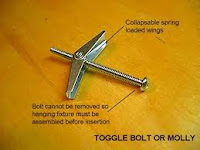First, although self-adhesive Velcro is popular for lightweight items, it doesn't have a lot of holding power, and in hot weather the adhesive tends to peel right off the wall. 3M Dual Lock and Radio Shack Superlock work in a similar way, but are much stronger. Here’s a great article that tells you everything you could possibly want to know about Dual Lock.

Mounting putty (DAP Fun-Tak, BlueStik or the generic equivalents) can be used to mount posters or other very lightweight items to walls, but its main use is to secure items to counters so they won't wander off while you're driving down the road. You can find these reusable putties in the stationary department of any large store, and a package is a good thing to have around.
Mounting shelves can be done with either screws or hollow-wall anchors ("Mollies"). while hollow-wall anchors will support more weight in theory, they require a considerable amount of space behind the wall in order to work, and that can be hard to find in an RV. You can replace the screw with a shorter one that may make it easier to use in the narrow space of the RV wall. Also, get ones with the shortest anchors you can find.


Here are two of several different types of wall anchors. You can how the length of the screw can be a problem in a thin wall.
Screws are probably better; 1/2" long #6 pan-head screws are good for mounting almost anything in the rig, because they are fat enough to get a good grip on the wall, yet short enough that there's very little fear of puncturing a wire or pipe--they just don't go that deep.
You should use an electronic stud sensor to check for solid wood behind those hollow walls. If you can find a stud where you're going to put a mounting screw, then by all means drive a longer (1" or 1 1/2") screw into the stud--that way you'll be really confident of its holding power. This is obviously recommended for shelving. If the shelf is light, you can get away with using 1/2" screws into the paneling.
Contributors: Steve, Kate Klein, Andy Baird, Chris Horst